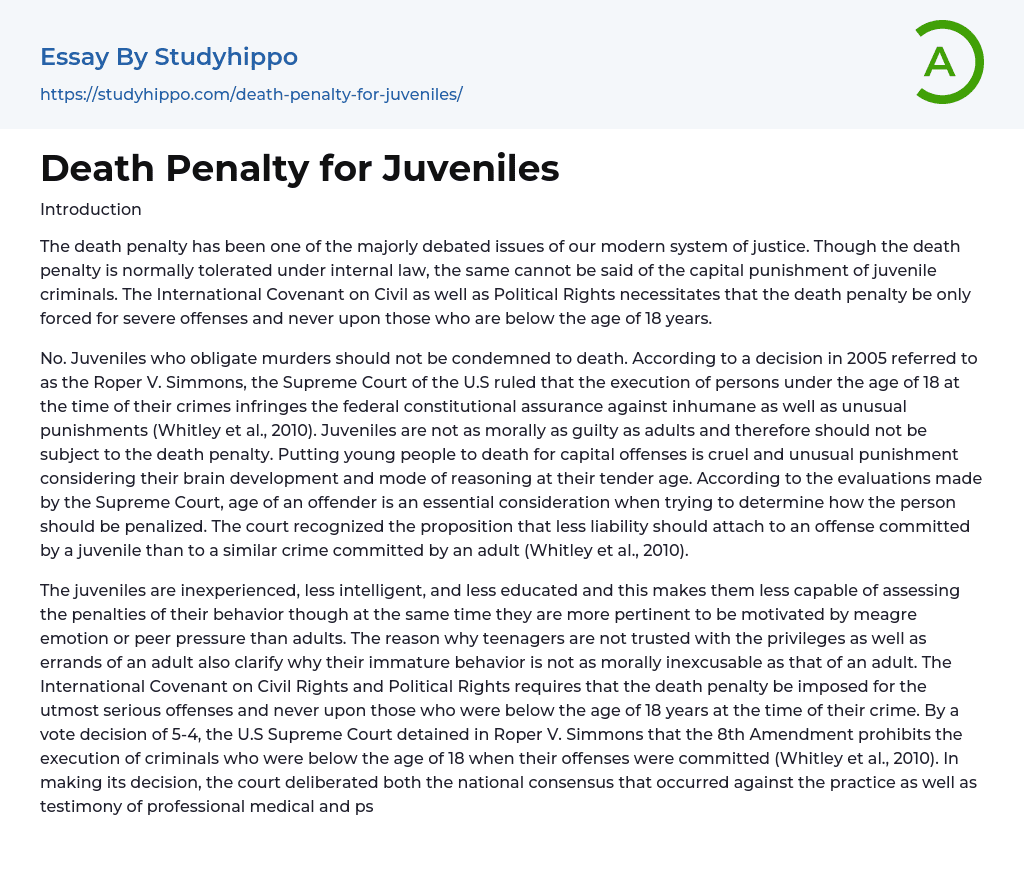Introduction
The death penalty has been one of the majorly debated issues of our modern system of justice. Though the death penalty is normally tolerated under internal law, the same cannot be said of the capital punishment of juvenile criminals. The International Covenant on Civil as well as Political Rights necessitates that the death penalty be only forced for severe offenses and never upon those who are below the age of 18 years.
No. Juveniles who obligate murders should not be condemned to death. According to a decision in 2005 referred to as the Roper V. Simmons, the Supreme Court of the U.S ruled that the execution of persons under the age of 18 at the time of their crimes infringes the federal constitutional assurance against inhumane as well as unusual punishments (Whitley et al., 2010). Juveniles are not as mo
...rally as guilty as adults and therefore should not be subject to the death penalty. Putting young people to death for capital offenses is cruel and unusual punishment considering their brain development and mode of reasoning at their tender age. According to the evaluations made by the Supreme Court, age of an offender is an essential consideration when trying to determine how the person should be penalized. The court recognized the proposition that less liability should attach to an offense committed by a juvenile than to a similar crime committed by an adult (Whitley et al., 2010).
The juveniles are inexperienced, less intelligent, and less educated and this makes them less capable of assessing the penalties of their behavior though at the same time they are more pertinent to be motivated by meagre emotion or peer pressure than
adults. The reason why teenagers are not trusted with the privileges as well as errands of an adult also clarify why their immature behavior is not as morally inexcusable as that of an adult. The International Covenant on Civil Rights and Political Rights requires that the death penalty be imposed for the utmost serious offenses and never upon those who were below the age of 18 years at the time of their crime. By a vote decision of 5-4, the U.S Supreme Court detained in Roper V. Simmons that the 8th Amendment prohibits the execution of criminals who were below the age of 18 when their offenses were committed (Whitley et al., 2010). In making its decision, the court deliberated both the national consensus that occurred against the practice as well as testimony of professional medical and psychological organizations citing new proof of delayed brain maturation that effects responsibility determinations for juveniles.
One of the factors considered into account when deciding the category of these criminals is the determination of serious damage if the offender caused serious harm then he or she is generally classified as high risk. In numerous jurisdictions, initial evaluation leads on to a sentence management process in which the needs of the offender will be identified through an examination of factors like criminal history, employment history, family and background history, as well as specific offence related problems (Torsrud, 2012). These factors should be considered because the teenager might have been influenced by his parents in order to result to such heinous behavior. Moreover, these factors should considered since some of the children might also be charged with offenses that do not involve
homicide or even injury. Obligatory life without bail for a juvenile, impedes consideration of his chronological age and its guarantee characteristics such as immaturity, impulsiveness as well as failure to appreciate jeopardies and consequences (Torsrud, 2012). It averts taking into account the family and home environment that surrounds them whereby they are the key issues to be considered when it comes to death penalty for the children.
In conclusion, juveniles who commit murder should not be sentenced to death. They should be put into a rehabilitation center where they could adapt and change their behaviors. Juveniles are not as morally as guilty as adults and therefore should not be subject to the death penalty. Putting young people to death for capital offenses is cruel and unusual punishment considering their brain development and mode of reasoning at their tender age
References
- Torsrud, P. (2012). America unraveled. Place of publication not identified: iUniverse Com.
- Whitley, P., Goodwin, S. W., & Olson, C. (2010). 99 jumpstarts to research: Topic guides for
finding information on current issues. Santa Barbara, Calif: Libraries Unlimited.
- Affirmative Action essays
- Assisted Suicide essays
- Capital Punishment essays
- Censorship essays
- Child Labour essays
- Child Protection essays
- Civil Rights essays
- Corporal Punishment essays
- Death Penalty essays
- Empowerment essays
- Euthanasia essays
- Gay Marriage essays
- Gun Control essays
- Human Trafficking essays
- Police Brutality essays
- Privacy essays
- Sex Trafficking essays
- Speech essays
- Death Penalty Pros And Cons essays
- Is The Death Penalty Effective essays
- Animal Cruelty essays
- Charles Manson essays
- Crime Prevention essays
- Crime scene essays
- Criminal Justice essays
- Criminology essays
- Cyber Crime essays
- Damages essays
- Detention essays
- Distracted Driving essays
- Drug Trafficking essays
- Drunk Driving essays
- Forensic Science essays
- Gang essays
- Hate Crime essays
- Homicide essays
- Identity Theft essays
- Juvenile Crime essays
- Juvenile Delinquency essays
- Juvenile Justice System essays
- Law Enforcement essays
- Murder essays
- Organized Crime essays
- Penology essays
- Piracy essays
- Prison essays
- Property Crime essays
- Prostitution essays
- Punishment essays
- Punishments essays




